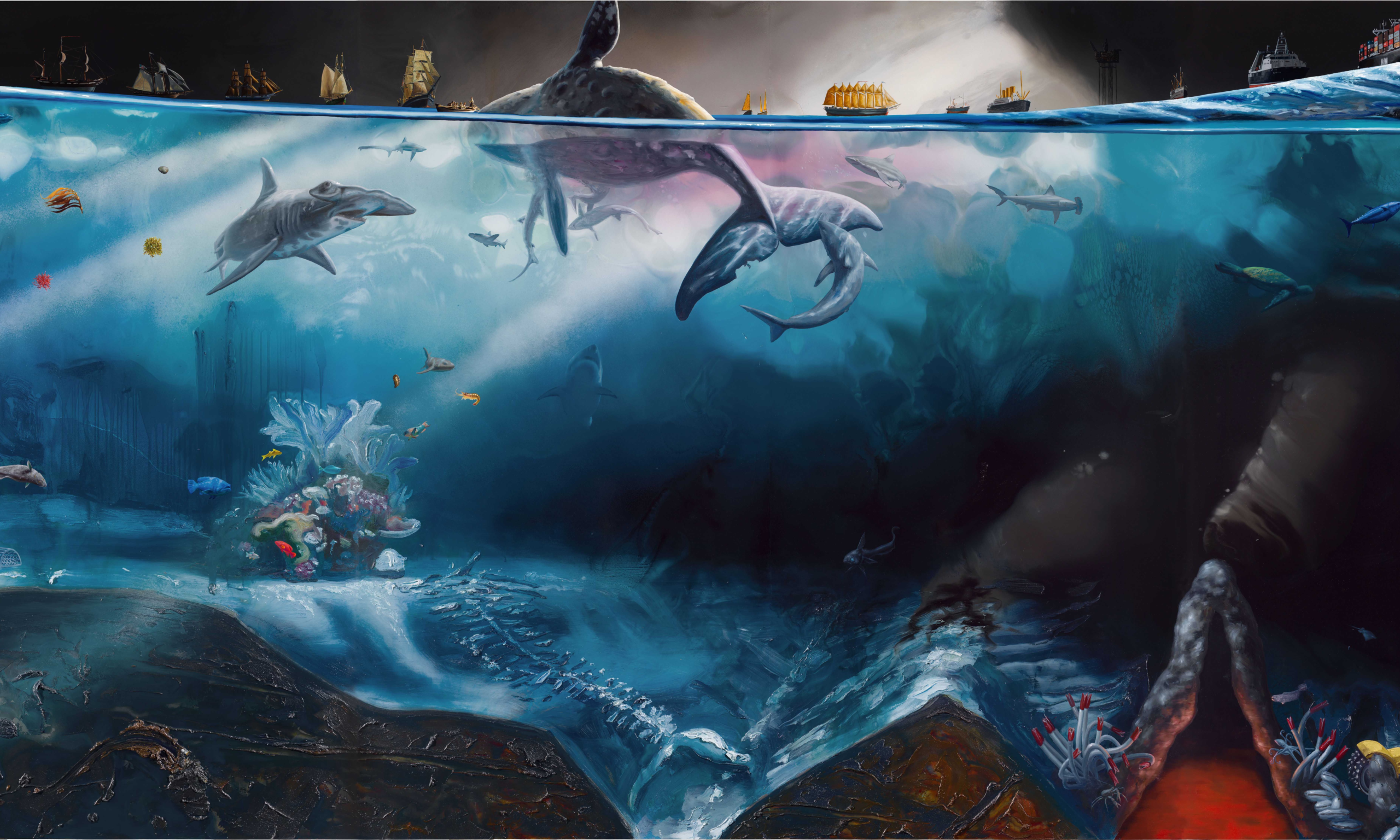Alexis Rockman’s 24ft-long painting Oceanus (2022), on show in his exhibition of the same name at the Mystic Seaport Museum until spring 2024 Courtesy the artist and Mystic Seaport Museum
For the first time in its nearly 100-year history, the Mystic Seaport Museum in Connecticut is addressing the impact of maritime industries on the ocean ecosystems. This new initiative is launching in tandem with Oceanus (until spring 2024), an exhibition of commissioned paintings by the New York-based artist Alexis Rockman.
Known for his captivating depictions of pressing climate issues, Rockman’s work for the museum focuses on the activities happening underneath the water’s surface, specifically the connection between seafaring and the introduction of invasive species. The exhibition marks a significant moment in the museum’s history as its first show dedicated to contemporary art.
“Museums should use their platform to inspire positive social change through awareness and conversation,” says Christina Connett Brophy, the museum’s senior vice-president. “We have been taking a critical look at the impact of maritime activities on the world’s oceans, beginning with our own Mystic River, which is now teeming with introduced species brought here in the ballast of ships and attached to their hulls.”
The highlight of the museum’s watercraft collection, for example, is the Charles W. Morgan, a mid-19th-century whaling ship that likely travelled a million miles carrying sand, microbes, plants and sea animals around the world. The museum studies these materials attached to its vessels in research conducted in partnership with James Carlton, the director emeritus of Williams-Mystic, the coastal and ocean studies programme of Williams College and the Mystic Seaport Museum. “Dr. Carlton continues to discover new species arriving in our waters every year,” Brophy says.
Alexis Rockman, Rafting the Humboldt Current, 2022 Courtesy the artist, Mystic Seaport Museum, Mystic, Connecticut
Rockman’s exhibition takes this research as a launching point. The 11 new works include a monumental oil painting that lends its name to the exhibition. At nearly 24ft long, Oceanus (2022) offers a remarkably detailed look at seafaring history and the underwater worlds it impacts. Along the top of the work are precise representations of 22 vessels, 16 of which are based on models in the museum’s collection. Arranged chronologically, the watercrafts begin with examples from Indigenous communities, including a Pequot muhshoon (dugout canoe), and end with a packed cargo ship, refugee raft and illegal fishing vessel. Interspersed is evidence of human impact on the ocean, such as fishing, whaling, fossil fuel extraction and transportation, as well as the many species living in the ocean. The work features more than 50 meticulously rendered examples of sea life—from whales and sharks to turtles and sea anemones—identified in a legend that accompanies each piece in the show.
“My challenge was taking many historical models of sea-going vessels and creating a compelling painting with these objects and corresponding resources that were exploited by them,” Rockman says. “Hopefully this will create an almost encyclopaedic image with many of the global issues that the oceans have and will continue to face from human activity.”
In addition to Oceanus, the museum commissioned Rockman to create ten large-scale watercolours, which are equally rich in scientific detail. Transient Passage (2022), for instance, is based on research by Carlton, Linsey Haram and Greg Ruiz examining how coastal animals are surviving hundreds of miles from shore by colonising plastic pollution. Giving a visual form to this research, Rockman’s work depicts various sea organisms thriving on a discarded plastic bottle.
Rockman’s Transient Passage (2022), a large-scale watercolour based on research into plastic pollution Courtesy the artist and Mystic Seaport Museum
Many of the watercolours are layered with art historical references, including Rafting the Humboldt Current (2022), an image of plants and animals using a raft to colonise new habitats that recalls Emanuel Leutze’s Washington Crossing the Delaware (1851). In Melancolia, Rockman’s concurrent exhibition at Sperone Westwater in New York (until 28 July), he offers further poetic images of climate change in scenes of calving icebergs and melting glaciers that weave in references to art historical figures such as Clyfford Still.
“Painting can do several things that can’t be achieved in other parts of our culture,” Rockman says. “Painting is visceral, intimate and bigger than our own scale. I hope the exhibition can [convey] some of the issues and challenges that the ocean faces in an impactful way.”
To accompany the exhibition, the museum is highlighting efforts in the so-called “blue economy”—a move to use oceanic resources sustainably—with an installation of such products, including items made of sea kelp, algae and lionfish pelt, as well as technologies to study the ocean.
“All museums seek to remain relevant to visitors, broaden our audiences and inspire meaningful dialogue,” Brophy says. “For maritime museums, this means thinking about what stories are going to be important in the future and how we can be an authentic resource for discussion. I hope our partner institutions join this conversation, as we all have something to bring to the table.”

